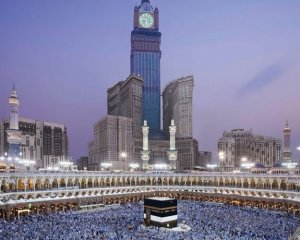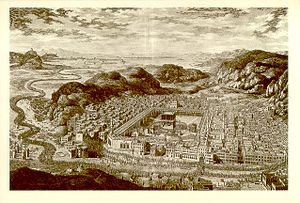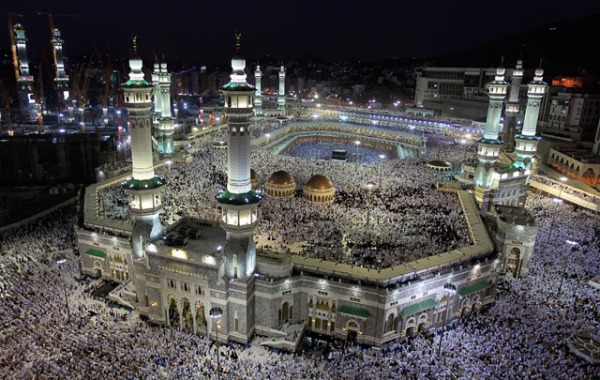History of Mecca – Beginnings and importance of the sanctuary
Mecca is a city of the region of Hiyaz, Saudi Arabia nowadays, and it is one of the most important cities of the Arabic Peninsula. It is in the west of the peninsula its population is approximately 1,675,368 people, according to a census carried out in 2010, it is in a narrow valley, 80km from the Red Sea and 277 meters above seaa level. The name that has had since its origin, in the muslims times, is Makka al Mukarrama, which means ‘Makka with honor’. The first person who referred to with the name of Makaroba (Makka Harb, which means ‘Meva of Harb (tribe name)’) was Ptolemy in the II century. Knowing the History of Mecca is not simple.
The most important of all the holy cities of Islam is the city in which Muhammad was born and it is visited evey year by thousands of pilgrims. This was a holy city for pagans, before Muhammad preached Islam, since it had many places with religious importance, such as the most memorable of all: Kaaba.
Pilgrimage to Mecca, according to muslims, is part of one of the fundamental aspects of faith, one of the pillars of Islam (which are faith profession, alms, prayer, fast and pilgrimage). That is why every year 3 million of pilgrims go to the city to carry out their major follow up or Hajj, during the muslim month of du I-hiyya. There are also other pilgrims who carry out a minor follow up or Umrah, which can be performed along the whole year. An approximate investigation, about the muslim visitors who go to Mecca every year, would reach the 13 million, adding the two follow ups (the major and the minor). On the other hand, very few non muslims have been able to the the Hajj rituals since non believers are banned from Mecca and Medina.
 Mecca is the religious center of muslims. Pilgrimage to this city is one of the five pillars of the muslim religion, which is a commandment for those who can do it. Infidels cannot enter this city, that is to say people outside the religion or ‘infidels’. This rite is of great importance for muslims and the tradition has its basis on characters shared with cristianism: Adan, Abraham, Sarah and Ismael.
Mecca is the religious center of muslims. Pilgrimage to this city is one of the five pillars of the muslim religion, which is a commandment for those who can do it. Infidels cannot enter this city, that is to say people outside the religion or ‘infidels’. This rite is of great importance for muslims and the tradition has its basis on characters shared with cristianism: Adan, Abraham, Sarah and Ismael.
According to muslim tradition, Mecca emerges because Adan received Allah’s order or request or building a place to worship Him. As time went by, that building disappeared. Years later, Abraham and Sarah appear, a couple who could not biget children. In such a situation, Sarah offers Abraham her Egiptian servant, Agar. She suggested he take her as his wife and try to have children through her. It was believed that if the servant gave birth on her mistress, the child belonged to the latter, not to the former. Therefore, they carried out all this and Agar got pregnant. She gave birth to a boy, who she called Ismael. However, Agar started to disrespect Sarah, her mistress, since having Abraham’s child made her feel in equal than Sarah, who complained to Abraham and they ended up expelling Agar from their tents.
Agar left with her son to the desert, were they remained wandering in search of a place where to stay. While they were walking, Ismael dehydrated and Agar got desperate searching water in the deser for her son. Suddenly, an angel appeared and Agar begged him not to let them dying from thirst. It emerged a well from the ground, which they called ‘Zamzam’. Agar and Ismael along with other people settled on that spot, and that was how Mecca or beka emerged. Abraham used to visit Agar and Ismael and he also received a message from Allah to create a place where people could go to worship. Abraham builds the place, which becomes a religious and worship center. However, over time, the real purpose of the place was forgotten; pilgrims started to take gods of all shapes and sizes, each of them giving Allah the shape or image they considered the best, so that the place became an idolatry site. History of Mecca is very well known in Islam.
All this remained this way until a man belonging to the hashemite faction, called Allah, went to Mecca and realized what the place has become into. He reminded the pilgrims that the aim of their pilgrimage was worshipping Allah: in simplicity, in union and with reverence. Above all, condemning the use of statues and images, reminding that the worship was only for Allah. This way, Mecca retook its spiritual and religious imprint.
Pilgrimages to Mecca were complicated and limited to those who had enough money and defined intentions of going to the place. Many people lost big amounts of money and sometimes even their lives during these pilgrimages. This was due to the fact that the path had mountains, deserts and many other obstacles; among them road bandits. Besides, the constant conflicts among different tribes from Arabia, increased the dangers of the trip, but due to pilgrimages to Mecca, it was decided to make truces for the pilgrims to make their way in peace. This also helped the conflict to be solved, helped trade development and gave a sense of identity that remains until nowadays.

Nowadays, muslims from everywhere in the world go to Mecca every year, not facing former problems anymore, since the Industrial Era made the pilgrimage much easier. Thanks to air traffic, we can see Europeans, Arabs and some Americans in this event. So big the affluence of people on this date is that the quota of Europeans and Arabs has been reduced. Besides, the importance of pilgrimage makes the believer focus on the religious experience and not worry about wordly affairs during the ten days that the rite lasts. All this the History of Mecca honour.
For muslims, pilgrimage to Mecca is the epic event and one of the pillars of the religion, an experiences that increases their faith and consolidates their beliefs. For the rest of the world, Mecca will continue being a myterious place marked by the enigma.
The name
Mecca is a Spanish way of saying the Arab name of the city, even though the official government transliteration is ‘Makkah’, which gets closer to the Arab pronunciation. For Spanish people, the word Meca comes from the Spanish Arab Mákka and from classical Arab ‘Makkah’, that has eded up to be used to make reference to the place where a lot of people go for being the best place where something takes place. Its use also extends to other languages, which has resulted offensive for several muslims, so that Saudi government adopted the word ‘Makkah’ as the official name and writing in the 80s, but even though being official, its use is not general inside the world.
As we said before, the word Makka al Mukarrama is translated ‘Makka with honor’. Its pronunciation would be maka Imukarrama. However, somtimes it is translated as ‘The holy city of Mecca’.
The ancient name of Mecca is Bakkah. Etymology of this Arab word is unknown because the belief that it was a synonym of Mecca was widely spread. Even though, it is said that is is the primitive name of the valley situated there. Therefore, Arab investigators use it to refer to the holy city around Kabba.
According to the Arab and Islamic tradition, another name that was given to Mecca, or to the mountains and wild lands around the city, is Faran or Paran since it makes reference to the deserts with the same names. This tradition says that the wild area is Faran and Mecca is Ismael’s place. On the other hand, a Syrian geographer of the XII century, Abu Abdallah Yakut ibn-Abdallah al-Rumi al-Hamawi said that Faran was an Arabized Hebrew word and one of the names that is given to it in the History of Mecca is Torah.
Before Muhammad’s arrival
The History of Mecca begins before, it is Adan who carries out the first construction of Mecca because of Allah’s request, according to Islamic tradition. This building faded with time until Ismael and Abraham’s arrival. Sarai was Abraham’s wife, but because of being sterile she offered her servant to her husband. It is she who conceives soon and Sarai, who was jealous, treats her harshly and forces her to escape to the desert with her son. Both mother and son were about to die from thirst when an angel appeared in front of them and asked them to beat the ground, which after being beaten, started to produce water until forming Zamzam well. It is around this well that they settle, along with other people, being here where Mecca emerges.
After several Abraham and Ismael’s visits because of Allah’s request, they suggest the kabba construction for the people to pilgrimage there, but over time they forgot to worship only one God and the different tribes started to take their stone gods to Mecca. It is like that that Mecca became a place for pilgrims with their different ways of idolatry. This situation lasted until the moment in which Muhammad arrived, who reminded believers that they only had to worship God without associating him to anything.
In the V century, a tribe called Quraysh took control of Mecca and their members became expert traders and merchants. Around the VI century, the spices trade was incorporated since the battles in different parts of the world were the reason to divert trade from sea routes, directing them to safer land routes.
Muhammad’s arrival
Muhammad was an Hashemite member, a faction of Quraysh tribe. He emigrated to Medina city in the year 622 along with some followers, lauching some nets against the trade of Mecca, after starting preaching against the city’s paganism.
During The Battle of Bad, which took place on 13th March 624 in the region of Hijaz, the leadership Mecca held was broken and Muhammad won a considerabe prestige among the different Bedouin tribes. However, the conflict persisted with the Battle of Uhus and the Battle of Trench.
Around the year 268, Muhammad acquired a more pacific posture. He tried, along with his followers, enter Mecca in pilgrimage, showing that traditional rites could be also acquired by Islam. That is why with the Treaty of Hudaybiyyah, it was agreed that muslims would be allowed to enter the city as part of a truce. Two years later, such a truce broke and it was the Mecca city which gave in Muhammad, who declared amnesty for the inhabitants and gave some presents to the main Quraysh.
He also created some of the most important changes and orded to destroy or retire all those cult images inside Kaaba that were for other gods who were not Allah. Kaaba became then in the holiest place of Islam and the center of pilgrimage. It was this way that several tribes from Arabia decided to accept Islam as their own faith, making Muhammad achieve what seemed impossible: gathering all the warrior tribes from the Arabic Peninsula in only one tribe. That is why his preach and his Koranic visions have created different summaries of beliefs, combining elements from Arabia, religious ideas, Jewish and Christian.
In the year 632 in the History of Mecca, Muhammad died but Islam began a quick expansion, mainly in North Africa and Asia, thanks to the fact that he transmitted the sense of unification to the Arabs. Over the years, while the Islamic Empire was expanding, Mecca also continued attracting more pilgrims, not only in Arabia but in the whole empire.
Another of the important changes that took place was that muslims had directed their daily prayers towards Jerusalem, but Muhammad ordered everyone to look at Kaaba instead.
Politics
Mecca has never been the capital of any caliphate at all, over the years. When Muhammad emigrated to Medina, the city was established as the first capital of Umma (community of Islam believers who profess their religion). Ali Ibn Abi Talib, Muhammad’s son in law, moved the capital to Kufa, Irak, the fourth of the called caliph, guided by Umma. But when Umayyad dynasty took power, they moved the capital to Damascus, Syria and later, Abbasid calilphate moved it to Baghdad, Irak.
That is why that the center of muslim Umma remained in Baghdad for approximately 500 years. There it flourished as the trade and investigation center. However, Mecca remained aloof from the struggles among different factions of muslims. In the year 930, the carmatas conquered and sacked the city, seizing the stone of Kaaba, not giving it back until many decades later.
Mongols invaded Irak and sacked the city, in the XIII century, making of it one of the most hated episodes in the Islamic History. Some time later, the Battle of Baghdad, which took place in the year 1258, Mongols reappeared conquering Syria, emerging quickly over Cairo, which became Umma center of power.
When Ottoman Empire turns powerful, the capital is moved to Constantinople and when pilgrims arrived for the Hajj, they payed their trips with the goods they sold in the markets of Mecca and with the acquisitions they sold when returning home.
History of Mecca in Islamic Politics during a brief period of time when some muslims opposed to the Umayyad Caliph, emerging Yazid I Caliph, who settled in Meca in the year 683.
Later, the city had a little space in Politics because it was a city destinated to devotion, which was ruled by Hashemites, sharifs of Mecca (city regents in protection of the holy places of Islam and pilgrims), Muhammad’s descendants. They governed on behalf of any muslim governor and stood as guardians of the two sacred mosques.
The Ottomans
The Turks took the city in the XVI century, remaining its domain under their control, even though they allowed the Hashemites sharifs, Muhammad’s descendants, to continue administrating it. In 1916, a chief called Husayn ibn Ali, became a Hijaz king after the uprising agains Ottoman power that afterwards would be known as the Arab Revolt.
Mecca was the capital of this ephemeral kingdom that later, in 1924, would be conquered by the Saudis, who connected their kingdom to central Arabia. In 1932, these two territories would be called Saudi Arabia.
Holy places in Mecca
Nowadays, the main industry in Mecca is hosting pilgrims who go for the Hajj, as well as pilgrims who visit the city in different times of the year, being their main stops Masjid al-Haram mosque and Zamzam well.
Masjid al-Haram: it is the first holy place of Islam and the main mosque of Mecca since it is considered the biggest in the world.
Kaaba: ‘The House of God’ is a fragment of meteorite covered with fabric, to which muslims pray five times a day since many muslims think it was built by Abraham and Ismael.
Zamzam well: it is believed it was revealed by Agar, Ismael’s mother. It is a hot dry valley, in which few water souces exist and that has special properties, such as relieving hunger and healing deseases.
Mine and Mount Arafat: small village in which it is said that the devil is represented by a 26 meter wall which pilgrims stone symbolically.

